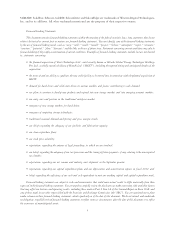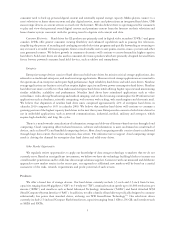Western Digital 2011 Annual Report Download - page 16
Download and view the complete annual report
Please find page 16 of the 2011 Western Digital annual report below. You can navigate through the pages in the report by either clicking on the pages listed below, or by using the keyword search tool below to find specific information within the annual report.assembly and testing, and maintaining close relationships with our strategic component suppliers to access best-of-class
technology and manufacturing quality.
Hard drive manufacturing is a complex process involving the assembly of precision components with narrow
tolerances and thorough testing. The assembly process occurs in a “clean room” environment that demands skill in
process engineering and efficient space utilization to control the operating costs of this manufacturing environment. Our
clean room manufacturing process consists of modular production units, each of which contains a number of work cells.
We continually evaluate our manufacturing processes in an effort to increase productivity, sustain and improve
quality and decrease manufacturing costs. We continually evaluate which steps in the manufacturing process would
benefit from automation and how automated manufacturing processes can improve productivity and reduce manufac-
turing costs. We leverage the efficiencies of contract manufacturers when strategically advantageous. For a discussion of
risks related to manufacturing, see Item 1A of this Annual Report on Form 10-K.
Materials and Supplies
We use a number of components, equipment, goods and services in the manufacturing of our products. The key
components of our hard drives are:
• magnetic heads;
• magnetic media;
• suspensions with related head gimbal assemblies (“HGAs”) and head stack assemblies (“HSAs”);
• spindle motors;
• custom and standard electronics such as system-on-chip, magnetic media, motor controllers, pre-amps and
printed circuit boards;
• base and top covers; and
• magnets and related voice coil motors.
We design and manufacture a substantial portion of the heads and magnetic media required for our hard drives. We
acquire all of the remaining components for our products from third party suppliers. The major components used in the
manufacture of our solid-state drives (the semiconductor media and system-on-chip) and in our media players (the
controller) are also acquired from third party suppliers. We believe that our sourcing strategy currently enables us to have
the business flexibility needed to select the highest quality, low cost of ownership suppliers as product designs and
technologies evolve.
We generally retain multiple suppliers for each of our component requirements but in some instances use sole
sources for business reasons. Currently, we believe that there are no major issues with component availability. For a
discussion of risks related to our component supplies, see Item 1A of this Annual Report on Form 10-K.
Backlog
A substantial portion of our orders are generally for shipments within 30 to 60 days of the placement of the order.
Customers’ purchase orders typically may be canceled with relatively short notice to us, with little or no cost to the
customer, or modified by customers to provide for delivery at a later date. In addition, for many of our OEMs utilizing
just-in-time inventory, we do not generally require firm order commitments and instead, receive a periodic forecast of
requirements. Therefore, backlog information as of the end of a particular period is not necessarily indicative of future
levels of our revenue and profit and may not be comparable to prior periods.
Patents, Licenses and Proprietary Information
We own numerous patents and have many patent applications in process. We believe that, although our patents and
patent applications have considerable value, the successful manufacturing and marketing of our products depends
primarily upon the technical and managerial competence of our staff. Accordingly, the patents held and applied for do not
ensure our future success.
10
























